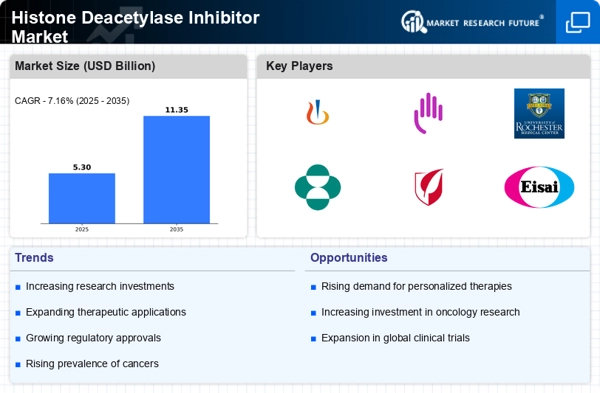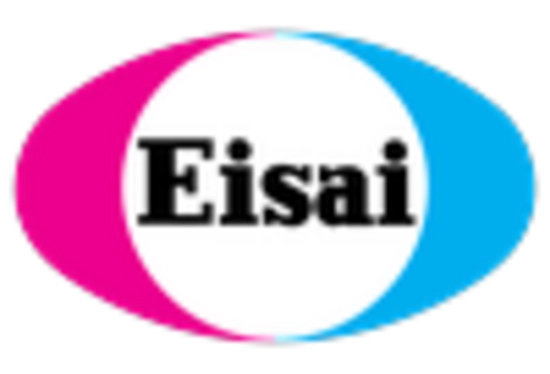The Histone Deacetylase Inhibitor Market is currently characterized by a dynamic competitive landscape, driven by a confluence of innovation, strategic partnerships, and a growing emphasis on personalized medicine. Major players such as Novartis (CH), Bristol-Myers Squibb (US), and Merck & Co. (US) are at the forefront, each adopting distinct strategies to enhance their market positioning. Novartis (CH) has focused on expanding its portfolio through targeted acquisitions, while Bristol-Myers Squibb (US) emphasizes research and development to innovate new therapies. Merck & Co. (US) appears to be leveraging its extensive distribution networks to enhance accessibility, thereby shaping a competitive environment that is increasingly reliant on both innovation and operational efficiency.
The market structure is moderately fragmented, with a mix of established pharmaceutical giants and emerging biotech firms. Key players are employing various business tactics, such as localizing manufacturing and optimizing supply chains, to enhance their competitive edge. This collective influence of major companies fosters a competitive atmosphere where agility and responsiveness to market demands are paramount. The interplay between these tactics and the competitive structure suggests a landscape where collaboration and strategic positioning are essential for sustained growth.
In August 2025, Novartis (CH) announced a strategic partnership with a leading biotech firm to co-develop a novel histone deacetylase inhibitor aimed at treating specific cancer types. This collaboration is significant as it not only expands Novartis's therapeutic offerings but also enhances its research capabilities, potentially leading to breakthroughs in treatment efficacy. Such partnerships are indicative of a broader trend where companies are pooling resources to accelerate drug development processes.
In September 2025, Bristol-Myers Squibb (US) revealed the results of a pivotal clinical trial demonstrating the effectiveness of its latest histone deacetylase inhibitor in combination with immunotherapy. This development is crucial as it positions the company at the intersection of two rapidly evolving treatment modalities, suggesting a strategic pivot towards combination therapies that could redefine treatment protocols in oncology. The implications of this trial could resonate throughout the industry, influencing competitive strategies across the board.
In July 2025, Merck & Co. (US) launched a new initiative aimed at enhancing supply chain reliability for its histone deacetylase inhibitors. This initiative, which includes investments in advanced manufacturing technologies, underscores the company's commitment to ensuring consistent product availability. As supply chain disruptions have become a critical concern in the pharmaceutical industry, Merck's proactive approach may serve as a model for others, highlighting the importance of operational resilience in maintaining competitive advantage.
As of October 2025, the competitive trends within the Histone Deacetylase Inhibitor Market are increasingly shaped by digitalization, sustainability, and the integration of artificial intelligence in drug development. Strategic alliances are becoming more prevalent, as companies recognize the value of collaboration in navigating complex regulatory landscapes and accelerating innovation. Looking ahead, the competitive differentiation is likely to evolve from traditional price-based competition towards a focus on technological advancements, innovative therapies, and robust supply chain management, reflecting a broader shift in the pharmaceutical industry towards value-driven strategies.

















Leave a Comment